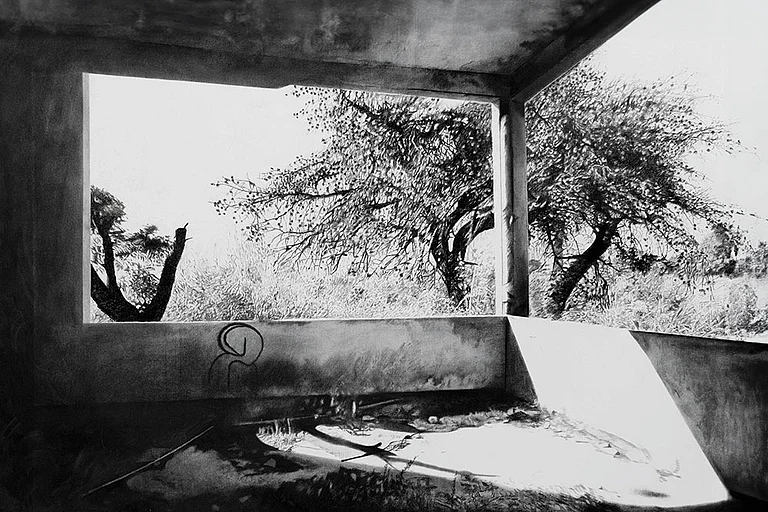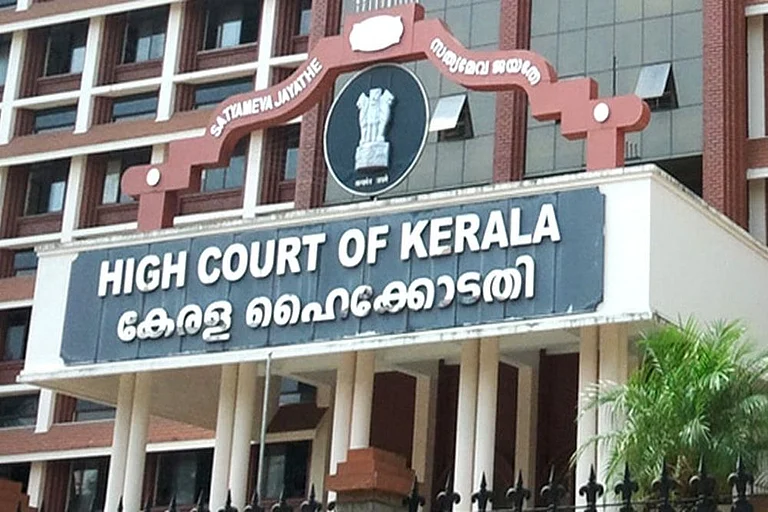The narrow road leading to Eganapuram village in Kanchipuram district of Tamil Nadu winds its way through the paddy fields, stretched as far as the eyes can see. The intense heat of summer creates shimmering mirages along the sun-baked road with dust hanging in the air, stirred up by the occasional passing of vehicles, casting a hazy veil over the landscape.
There is a temple at the village entrance. On the wall of the temple, a blackboard is affixed. It displays a striking message—“623rd day of protest: We want agriculture, we don’t want airport’. The significance of this solemn declaration hangs heavy in the air, hinting at the struggles and resilience of the villagers.
Not very far, a group of elderly women are sitting in the shade of a small dwelling, chatting and laughing, embodying the leisurely pace of rural life. When asked why the villagers do not want the airport, a calm but determinant Krishnammal, 81, says: “Our children are graduates, but they do not have employment. Agriculture is our only source of livelihood. The next generation will also do farming as we do not know anything else.” Will they agree for land acquisition if they get adequate compensation? One of them said: “Will they recreate a village like this for us? They might be giving us money to buy a house somewhere else, but we all will be separated. Can we sit together like this and chat?”
These women were highlighting the emotional aspects that are often overlooked while rehabilitating people who get displaced due to development projects. They were adamant about not going to the polling booths this time. “We will boycott the election. All political parties stand for the airport and there is no one to listen to us,” says Padmavati, 80, adding that the village has been their only home and this is where they want to die.
Eganapuram is among the 13 villages selected for acquisition as part of the proposed second airport project in Chennai in Parandur. The proposed Chennai Greenfield Airport (CGA), having a passenger capacity of 100 million per year, will be developed in 5368.93 acres at Parandur.
According to the pre-feasibility report prepared by the Tamil Nadu Industrial Development Corporation (TIDCO), the nodal agency of the project, 63 per cent of the project land is agricultural land and 27 per cent contains water bodies. The government-owned land constitutes 8 per cent of the project area. According to the TIDCO, 1,005 families will be affected and 36,635 trees will be chopped off. As per the government order issued on October 31, 2023, the approval for acquiring 3,774 acres of land was granted to the concerned departments on which the action has been commenced.
The project area is situated on mostly flat to gently rolling terrain, naturally draining into the Palar River and its tributaries. Besides, there are numerous ponds and local canals that are being utilised for irrigation. Paddy is the primary crop cultivated in the region, alongside groundnuts, sugarcane, cereals, millets, and pulses. Essentially, the project area constitutes a thriving agricultural community, where generations of villagers have relied on farming for their livelihoods.
Eganapuram village, home to 650 houses and 2,500 residents, faces complete obliteration with the construction of the airport. A staggering 905 acres of paddy fields would vanish along with it. The village, comprising 1,450 voters falling under the Sriperumputhur Lok Sabha constituency, currently held by the DMK, sees T R Baalu, the former Union Minister and sitting MP, vying for re-election against the AIADMK’s G Premkumar.
“There are 1,450 voters in our village and we have collectively decided to boycott this election,” states Subramani, the secretary of the Protest Committee. Despite the election fervour elsewhere, neither the DMK nor the AIADMK candidates have visited the village yet. There are no campaign flags or posters in the streets. “No one dares to come here; they have no answers to our questions,” adds Subramani.
Even though the share of the agricultural sector in the state GDP has declined from about 52 per cent in 1960-61 to 8.2 per cent during 2010-11, agriculture continues to be a major source of livelihood for the rural people. Agriculture still employs about 40 per cent of the workforce in the state. In Eganapuram village, almost all households are engaged in agriculture, including the young generation. A total of 905 acres of land is being cultivated three times a year and gets an average yield of 2,500 kg of rice per acre. The villagers do not agree with the perception that agriculture is becoming unaffordable and the youngsters are not interested in farming anymore. “Every household occupies one to four acres of land. People are able to manage their humble lives by the yield from this land. They do not need big money,” says Lokesh Prathipan, a native of Kanchipuram, a graduate in geology who looks into environmental activities in the locality.
Concerns regarding displacement and rehabilitation for development projects are inherently local and complex. For the residents of these villages, rehabilitation entails more than just financial compensation and relocation. The bonds of community, the familiarity of neighbourhoods, and the deep sense of belongingness cannot be quantified in monetary terms. Senior citizens in the affected villages express deep concern over the potential loss of their shared way of life and cultural heritage, cultivated over generations.
Reflecting on her own experience, Krishnammal highlights the challenges faced by those uprooted from their ancestral homes. Despite returning to her village after marriage due to a lack of agricultural land elsewhere, she was treated like a migrant for an extended period. This raises questions about the acceptance and integration of displaced individuals into new communities. The fear of perpetually holding a secondary status as migrants underscores the emotional complexities surrounding displacement and rehabilitation.
Owning land holds significance beyond mere agricultural pursuits and earning livelihoods. It serves as a lasting asset, crucial for financing children’s education. Bhaskar, a 54-year-old resident of Nelvoy village—one of the 13 that awaits land acquisition—illustrates this point by recounting his own experience. He pledged his land to fund his eldest son’s engineering education, using the proceeds from farming to repay the loan. Subsequently, the same land was pledged for his second son's education. “This is a common practice among villagers,” Bhaskar explains. “Even if our children do not secure employment immediately after completing their studies, we can repay loans when our crops yield well. Without land, how would we manage our children’s education?” Numerous farmers in Nelvoy village echoed similar sentiments, substantiating the vital role of land in financing education expenses and loan repayment through agricultural income.
However, the concerns and preferences of landholding farmers and landless agricultural labourers differ. While both groups are apprehensive about the land acquisition for the airport project, some landless agricultural labourers, particularly Dalits, express readiness to accept compensation and relinquish their property. In villages like Nelvoy and Eganapuram, 60 per cent of the population belongs to the Vanniar caste—one of the prominent Backward Classes in Tamil Nadu—while 40 per cent are Dalits. The majority of landholding farmers are Vanniars, whereas Dalits primarily work as landless agricultural labourers. However, there are also a few Dalit families who own land.
A statue of Dr Ambedkar, situated at the entrance of the road leading to the Dalit area, symbolises the enduring caste divisions within the village. Like many other Indian villages, Dalits inhabit a distinct locality, with the majority working as landless agricultural labourers on fields owned by Vanniars. Despite this social stratification, members from both communities affirm that the village has remained free from historical caste conflicts.
Sachin, a 28-year-old Dalit entrepreneur, runs a ‘sounds service shop’ within the village. The influence of Ambedkar was visible in the village, particularly evident in the preparations underway for celebrating Ambedkar Jayanti.
Sachin’s shop is adorned with a striking wall-hanging photograph of Ambedkar, while two workers diligently wire lights around an Ambedkar statue for the the upcoming celebration on April 14.
Though Sachin’s family has no land holdings, he is against the proposed airport project and stands for preserving the agricultural landscape. “Here, people find sporadic employment in private companies for only a few months each year. In contrast, agriculture provides steady work for at least six months annually, ensuring a reliable income,” Sachin asserts, emphasising the importance of maintaining agricultural livelihoods within the community.
The Dalit women that we met in the village have mixed responses to the proposed Airport project and subsequent displacement. Udayakumari, aged 60, and her neighbour Sangeetha, 35, residing in Nelvoy village, are open to relocating if provided with adequate compensation. “We have no land; this tiny house is our sole possession. Some families here don't even have their own homes. If we receive a fair sum, we are prepared to move,” explains Udayakumari. Similarly, Chithra, a 40-year-old Dalit from Ekanapuram village, shares this sentiment, expressing uncertainty about remaining in the village. However, none of these women show interest in the upcoming elections and have no plans to visit the polling booths.
A recent Geographic Information System (GIS) study indicates that the Parandur site is flood-prone for being saturated with significant water bodies at full capacity. This poses a threat of inundation to airport runways during heavy rainfall, as there are inadequate natural drainage systems. The GIS study was carried out by Dayanand Krishnan, a Chennai-based civil engineer, who has done prior consultations with Chennai Metro and Greater Chennai Corporation. The presence of a large lake spanning 500 acres adjacent to one of the runways enhances the possibility of flooding.
The GIS is a tool for location-based data analysis that provides crucial insights into environmental impacts. According to Dayanand, Pannur, another site that was in consideration for the same project, is more suitable considering the ecological loss as it has fewer and smaller water bodies. The people in the villages hold the view that the proposed project area, which is an abundant source of water, should be preserved as a reservoir for the water requirements of Chennai instead of converting it into an airport.
The thousand-plus families across 13 villages whose livelihood is predominantly agriculture live in deep uncertainty and agony. The villagers express frustration that neither the authorities, including the District Collector, nor the members of the Legislative Assembly, have provided explanations for selecting Parandur for the project over other available options. In the absence of anyone addressing their grievances, the upcoming election holds little significance for them.
The resistance against the proposed Green Field Airport has persisted for 626 days as of April 12, 2024. Each night, villagers convene near the temple at the village entrance, holding meetings and affirming their commitment to continue the battle to the best of their ability. They vow not to relinquish the agriculture and water bodies for the project.



























